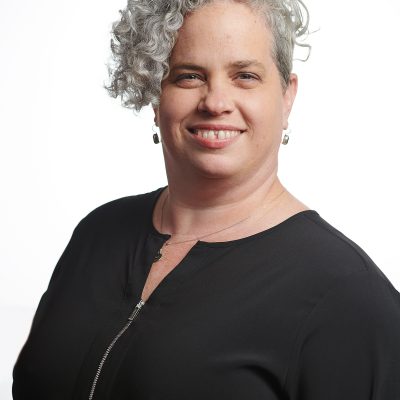
“Photography has a special capacity to serve the public interest,” Media Impact Funders Executive Director Vince Stehle told attendees at the March 5 Media Impact Focus event, AIM and Shoot. And who could imagine a better venue to explore this topic than the Skylight Studios of the Annenberg Space for Photography?
Annenberg Foundation Executive Director Leonard Aube — himself an avid photographer specializing in marine life — welcomed the group to a day of discussions that alternated between photography’s capacity to inspire and mobilize viewers, and the rapidly evolving arena of media impact analysis. The sessions revealed that while documentary photography is a new topic for Media Impact Funders, philanthropists and practitioners in this field are grappling with many of the same questions facing journalists, filmmakers, and other public interest media producers.
Wendy Hanamura, Chief Digital Officer at KCET Link, the leading public television broadcaster in Los Angeles, served as the day’s emcee. She summed up some common themes: the power of both “moving images, and how images move us,” a focus on resources “both environmental and financial,” and the ways in which both photography and documentary are “morphing and stretching in new directions.”
The Impact Conversation Deepens
The event was bookended by two sessions that picked up where Media Impact Funders’ November MIFocus event at the Paley Center left off. With support from key funders, the field of media impact analysis has begun to coalesce.
Chad Boettcher, the Executive VP for Social Action and Advocacy at Participant Media was joined by Caty Borum-Chattoo, a Public Affairs Strategist at Participant Media and Creative Director for American University’s Center for Media & Social Impact. They presented on the latest evolution of The Participant Index (TPI). This multifaceted research initiative analyzes media impact through a calculation that includes the scale of the reach of a particular piece of media, and the behavior shifts it has inspired.
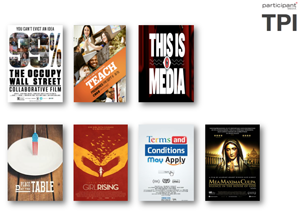 Borum-Chattoo has been working on the TPI pilot survey process, which polled 7,500 people from across the country about their responses to a range of productions, including documentaries, narrative films, TV shows and online videos. This initial foray has allowed the team to develop initial working typologies of different sorts of activists — passive, casual, engaged, and passionate — as well as a set of viewer clusters: nearly nones, blockbuster buyers, periodic primetimes, film fanatics, often onlines, sofa surfers, and voracious viewers.
Borum-Chattoo has been working on the TPI pilot survey process, which polled 7,500 people from across the country about their responses to a range of productions, including documentaries, narrative films, TV shows and online videos. This initial foray has allowed the team to develop initial working typologies of different sorts of activists — passive, casual, engaged, and passionate — as well as a set of viewer clusters: nearly nones, blockbuster buyers, periodic primetimes, film fanatics, often onlines, sofa surfers, and voracious viewers.
These distinctions allow the researchers to think through different ways to target particular groups, especially those “beyond the choir,” she said. They are also examining the relationship between “narrative transportation” and action. Emotion is not enough, Borum-Chattoo observed. A production has to be relevant to an audience member’s life to move him or her to take any action, from sharing, to voting, to organizing, to changing perceptions and habits.
This session offered an opportunity for Participant Media to formally announce their research partnership with the Media Impact Project (MIP), which launched in 2013 with joint funding from the Bill & Melinda Gates Foundation and the John S. and James L. Knight Foundation. The project is housed at the Norman Lear Center at the University of Southern California’s Annenberg School for Communication and Journalism.
In the afternoon the Lear Center’s Founding Director Marty Kaplan explained the genesis of MIP, which built upon previous successful research initiatives, such as Hollywood Health and Society. Kaplan described the center’s approach as interdisciplinary, academic, applied, and pro-social. He then introduced Managing Director/Director of Research Johanna Blakley, whose research into audience responses to Food, Inc. was seminal to TPI’s creation. Blakley explained her approach to testing the impact of the film as similar to a “clinical trial” in that it compared responses of those who had been exposed to the documentary to similar audience members who had not. MIP will continue to refine this approach, which is called “propensity score matching.”
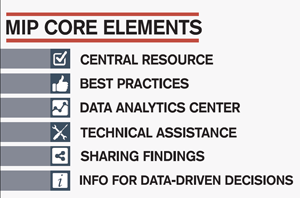 MIP Director Todd Cunningham explained other ways the project plans to provide more tools for observing audience behaviors. They are partnering across several departments at USC to build tools and surface best practices, from neuroscience, to engineering, to cinema, and beyond. Their research and partnerships will target “all media measurement communities,” he said: domestic and international, news and entertainment, nonprofit and for-profit, across all platforms. MIP researchers will also draw approaches from the fields of market research, social analytics, longitudinal relationship-building, and crowd-built tools, as well as edgier methods such as “deprivation studies,” which involve limiting subjects’ access to favored media in order to surface what’s most valuable about them. In the coming months, they will develop a secure data analytics center, as well as user dashboards and tools that will facilitate shared learning across media projects.
MIP Director Todd Cunningham explained other ways the project plans to provide more tools for observing audience behaviors. They are partnering across several departments at USC to build tools and surface best practices, from neuroscience, to engineering, to cinema, and beyond. Their research and partnerships will target “all media measurement communities,” he said: domestic and international, news and entertainment, nonprofit and for-profit, across all platforms. MIP researchers will also draw approaches from the fields of market research, social analytics, longitudinal relationship-building, and crowd-built tools, as well as edgier methods such as “deprivation studies,” which involve limiting subjects’ access to favored media in order to surface what’s most valuable about them. In the coming months, they will develop a secure data analytics center, as well as user dashboards and tools that will facilitate shared learning across media projects.
While MIP is just getting off the ground, Cunningham offered a few early lessons. They have developed their own working taxonomy reflecting the “verbs” of online action: consuming, amplifying, contributing, subscribing, transacting, and catalyzing. He noted, however, that offline measurement is just as or more important than online. He also restated MIP’s commitment to analyzing qualitative data, which he said is often the “nectar” in the story of how media makes change. Here’s the full Media Impact Project presentation.
The announcement of this high-profile TPI-MIP research partnership, and the progress that both have made in synthesizing frameworks for understanding user behavior represent significant steps forward in the nationwide effort to build better tools for gauging public interest media. We will be tracking what comes next in our AIM section.
Documentary Impact in Practice
The two sessions on impact also featured compelling presentations on highly effective social issue productions, including:
- To the Arctic — Shaun MacGillivray described the impact of his stunning IMAX film, which chronicles an unforgettable journey of a mother polar bear and her two seven-month old cubs as they navigate the rapidly changing Arctic Wilderness. “We wanted to document the Arctic before it disappeared,” MacGillivray said. Through long-running partnerships with museums and science centers, such films can be seen by millions and strongly inspire young viewers. Working with partners including the Smithsonian, Coca-Cola, and the World Wildlife Fund, and with signature support from the Campion Foundation, the team at MacGillivray Freeman Films spearheaded a global giving campaign, Arctic Home, which has raised more than $4 million to support research into polar bear habitats, and boosted awareness of the rapidly melting Arctic sea. The project built upon Coca-Cola’s longstanding use of polar bears in the company’s iconography, and WWF’s two-decade long Arctic conservation program. MacGillivray also spoke about how gratifying it has been to hear stories of kids inspired to become marine biologists after seeing the studio’s films.
- Unmanned: America’s Drone Wars — Jim Miller, the Executive Director of social impact production studio Brave New Films spoke about the public response to the studio’s latest documentary, which investigates the impact of drone strikes at home and overseas. More than 600 people donated to help finish the film and bring strike victims to the U.S., and the Unmanned campaign involves a dozen different partners, including the ACLU, the Center for Constitutional Rights, and Code Pink. The Brave New Foundation also produced a related action guide. They’re tracking how Unmanned spurs conversation, influences legislation, and changes attitudes. Support for drones has been sinking, he noted, and while they can’t prove causation, related shorts have been viewed on YouTube some 750,000 times, the campaign has generated more than 700 press hits and 76,000 Facebook likes, and the film has been screened across Pakistan. They timed the release to coincide with influential white papers examining drone policy, as well as a related Congressional briefing called by Representative Alan Grayson that featured a clip from the film and testimony from a Pakistani family injured in a drone strike.
- Stand Up Planet — Comedian Hasan Minhaj offered an entertaining account of how he came to host a new Gates Foundation funded show, Stand Up Planet, which asks “Can you follow a joke to something deeper?” It will air on KCETLink, and many other networks around the globe this April, showing how Minhaj visited Mumbai and Johannesburg in search of the comics pushing boundaries and turning some of the world’s toughest problems into punchlines. He spoke from his own personal experience about how comedy can help to highlight issues and cast a light on things that are — or should be —different. Comedians can “call B.S.,” he said, and don’t need to do so from the perspective of advancing an agenda. Any joke is fair, Minhaj said, as long as you “punch up”—that is, don’t attack those with less power.
Documentary Photography’s Legacy and Future
AIM and Shoot attendees began the day’s consideration of why photography matters with a private viewing of the exhibition on display at the Annenberg Space for Photography — The Power of Photography: National Geographic 125 Years.
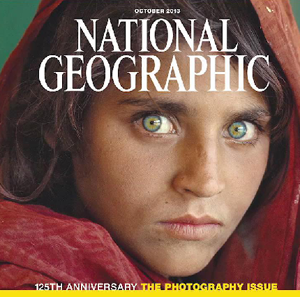 This unprecedented exhibition presents mosaics of more than 400 photos documenting the history of National Geographic photography from 1898 to the present, plus more than 500 additional images looping through wall-sized LED monitors arrayed throughout the gallery and video interviews with featured photographers. This installation was created in conjunction with the October 2013 publication of a collector’s issue of National Geographic, which was distributed to attendees. Titled The Photo Issue, it uncovers the various roles that photos can play in public life: to witness, prove, relate, reveal, celebrate, and protect.
This unprecedented exhibition presents mosaics of more than 400 photos documenting the history of National Geographic photography from 1898 to the present, plus more than 500 additional images looping through wall-sized LED monitors arrayed throughout the gallery and video interviews with featured photographers. This installation was created in conjunction with the October 2013 publication of a collector’s issue of National Geographic, which was distributed to attendees. Titled The Photo Issue, it uncovers the various roles that photos can play in public life: to witness, prove, relate, reveal, celebrate, and protect.
The curators and editors of the Power of Photography collaboration stepped up to the stage to take attendees deeper: Pat Lanza, Director, Talent & Content, Annenberg Space for Photography; Dennis Dimick, Executive Editor (Environment), National Geographic Magazine, and Pamela Chen, Senior Photo Editor, National Geographic Magazine.
Lanza is a photographer herself, and worked as a National Geographic photo editor. She said that this has been one of their most complex and popular exhibitions, with audiences lining up to see it. The power of photography, she said, is “listen and I’ll probably forget; show me, and I probably will remember.”
Dimick walked attendees through several special photo-based issues and series, including those focused on water scarcity, population growth as exemplified by the faces and fates of young women, the rising issue of food diversity, and a “burning question: How can we create smart cities?” He pointed to the work of photographer James Balog as a prime example of how photography can be used as evidence in high-stakes scientific debates. In a video produced for the exhibition, Balog, who founded the long-term photography project Extreme Ice Survey, says of the issue of vanishing glaciers: “It doesn’t matter what your political creed is: it belongs to everyone.”
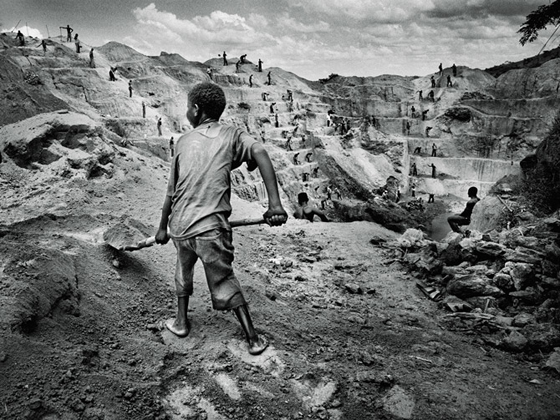
Chen spoke further about how new digital platforms are changing the ways that photographers work, and how the editorial team works with them to achieve political and social goals. For example, Marcus Bleasdale’s photos of natural resource use in the Congo — shown above, and featured in the October 2013 issue — demonstrate how photographers can serve as witnesses to ongoing injustices. By documenting the ways in which corporate mining for minerals used in mobile phones, computers, and cameras underwrites a “hodgepodge of rebel groups” and a corrupt government army, Bleasdale has been able to provide evidence used by US advocates and policymakers to draft legislation calling for transparency from U.S. companies on their mineral sources. Leading electronics firms such as Intel, Motorola and HP are now auditing their supply chains, and Congolese authorities have begun to inspect and regulate mines.
Support from the Open Society Foundations helped to amplify Bleasdale’s work, and the photographer also leveraged social platforms such as Instagram to generate further awareness. In a related video, Bleasdale described photos as just “the start of the process …it’s not the individual photograph, it’s who you engage with it that makes it powerful.”
A Look at Local
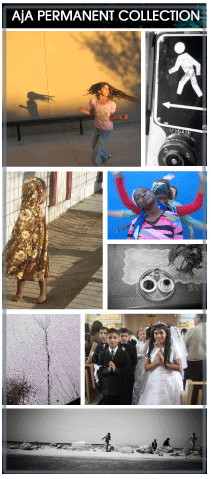 After hearing National Geographic’s global perspective on photography, attendees got a chance to experience two very different perspectives from local producers who are creatively using photography to address civic issues:
After hearing National Geographic’s global perspective on photography, attendees got a chance to experience two very different perspectives from local producers who are creatively using photography to address civic issues:
Sandra Ainslie, the Executive Director of The AjA Project, described how her project gives both cameras and the power to represent themselves back to the subjects via a process called “participatory photography,”. First, AjA students look inward to contemplate facets of their identity. Many are recovering from conflict, but they’re encouraged to contemplate other selves, and through images, explore evolution of their personal narratives “within their own minds.” Once these participants begin to reconsider their own stories, the impact of documenting their lives begins to ripple out to their communities, allowing them to critique the ways in which they are marginalized. The Speak City Heights project shows how work by these young photographers can then be placed on par with “traditional media voices,” Ainslie said. Youth photographer Nick Beda, who came from the South Sudan, joined her onstage to speak about his own experience. Beda said that the AjA Project gave him confidence and taught him there are many modes of expression: “When we find the way that works for us, it makes us free.”
Juan Devis, the vice president of arts and culture programming for KCETLink, was joined by emcee Wendy Hanamura for a conversation about a very different type of project, designed to expose photography’s deep roots to local resources. “In this intensely digital era, we wanted to show you an exploration of something purely analog; the tactile image; something elemental,” Hanamura said. “How do you make a photo of a landscape from the very elements of the landscape itself?”
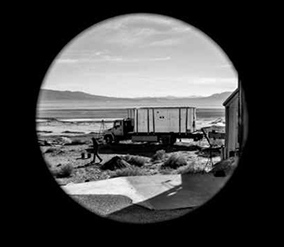 Devis worked with artist Lauren Bon and her Metabolic Studio to document the creation of an “indexical image” using silver, water, and chemicals culled from Owens Valley outside of LA. An hour-long special episode of Artbound, titled “AgH20,” peeled back the layers of this profoundly conceptual project, which ArtBound viewers chose as one to focus on as part of the program’s larger participatory structure. Devis explained that the program draws upon local art critics as columnists. Stories voted up by audience members are then produced as films that are eventually aired, opening the traditionally hermetic sphere of art criticism, and providing an alternative model for public media to engage with audiences, artists, and communities. In the case of Bon’s work, Devis said, the challenge was to tell the story of an image that is not representational. He compared the process to producing a cooking show. Bon’s aim is to create projects on the same scale as the environmental destruction she documents.
Devis worked with artist Lauren Bon and her Metabolic Studio to document the creation of an “indexical image” using silver, water, and chemicals culled from Owens Valley outside of LA. An hour-long special episode of Artbound, titled “AgH20,” peeled back the layers of this profoundly conceptual project, which ArtBound viewers chose as one to focus on as part of the program’s larger participatory structure. Devis explained that the program draws upon local art critics as columnists. Stories voted up by audience members are then produced as films that are eventually aired, opening the traditionally hermetic sphere of art criticism, and providing an alternative model for public media to engage with audiences, artists, and communities. In the case of Bon’s work, Devis said, the challenge was to tell the story of an image that is not representational. He compared the process to producing a cooking show. Bon’s aim is to create projects on the same scale as the environmental destruction she documents.
Philanthropy’s Role in a Tumultuous Time
Amy Yenkin, the director of the Open Society Foundations (OSF) Documentary Photography kicked off the final photography session by observing that the National Geographic has become a very rare institution — for the most part, print journalism can no longer support large-scale, multi-year photography series. While documentary photography is just a small part of OSF’s portfolio, it represents a significant investment in a field where photographers are struggling to get by and competing with the ever-burgeoning supply of digital photos now available online. Fostering independent voices is a core component of civil society,” said Yenkin. “Photography is a key part of this.”
Yenkin worked closely with her fellow panelists — Susan Meiselas, the president of Magnum Cultural Foundation; Emma Raynes, the program director of the Magnum Foundation Emergency Fund, and Sara Terry, the founder and artistic director of the Aftermath Project — to present a rich session that further clarified how funders can support photojournalists. These presenters also curated this meaty list of resources designed to orient attendees to the field’s myriad opportunities and challenges.
OSF is one of the largest funders of documentary photography, and Yenkin spoke about how images have been used to advance a core priority, criminal justice reform in the United States. Fundamentally, she said, the foundation is interested in “what can happen after the photos are shot.” But that does not mean exercising editorial control over photographers. “Independence is paramount,” said Yenkin. Projects begin with “the photographer’s curiosity,” and then dovetail with relevant issues.
She offered two examples:
- Grace Before Dying — Photographer Lori Waselchuk, who took the photo above, documented a successful prison hospice program in the Louisiana State Penitentiary at Angola. She worked with advocates and prisoners to build a case that other such programs be established. An OSF Audience Engagement Grant allowed her to create a traveling exhibition for display in correctional facilities, museums, libraries, hospitals, colleges, and community centers.
- Year Ten — This project focused on closing Tamms, an Illinois supermax prison. A particularly moving element included photo request from solitary, which were exhibited in a pop-up shipping container. The campaign that this project was associated with celebrated success: the prison was closed.
While such impact is important, says Yenkin, in general funders should be looking for “contribution, not attribution” when working to figure out how photos operate as part of a larger movement. Social change “takes time and does not move in one direction,” she observed. OSF’s grants are small, so they ask recipients to focus on targeting an audience. High-impact photo projects tend to be tactical, participatory, and viral, and are strengthened by issue expertise at the foundation level. Working with partners such as the Magnum Foundation also helps to amplify OSF investments.
Meiselas described how her organization is supporting photographers during this moment of massive transition. The Emergency Fund provides modest funds to independent photographers in documenting issues “off the media map,” she said, allowing them to travel to a region and “keep critical eyes on the world.” There are also now fewer editors and writers working with photographers, so they partner with publications such as Time and Mother Jones. They are trying to sustain “anticipatory rather than reactive reporting.” In partnership with Atlantic Philanthropies, they’ve created a project to document the foundation’s capital investments across seven countries, which includes mentorships for young local photographers “We value insider perspectives on locally relevant issues,” she said.
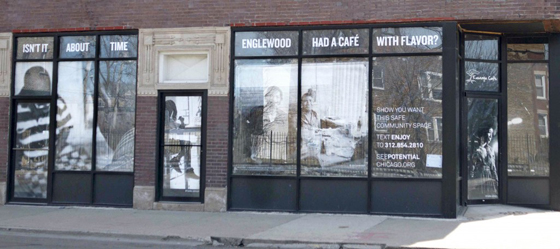
The Magnum Foundation is invested in the long tail of the stories being documented, and is actively seeking ways to track related impact and mobilization. Reynes offered Emily Schiffer’s photos on the issue of food insecurity in Chicago as an example of a successful project. It led to the creation of See Potential, a community engagement initiative that installs large-scale documentary photos such as those pictured above to prompt community dialogue and support for development on Chicago’s South Side. A related map tracks each See Potential location, and participants are encouraged to text responses, which are then shared with local officials and investors.
The foundation’s Photography Expanded initiative also offers training and convenings for photographers to help them grasp new approaches, explained Reynes. They are working to foster partnerships with platforms such as Twilio that offer new tools for photographers, and to showcase transmedia activism projects such as Sandy Storyline, which demonstrate the promise of images as one pole in a broader engagement strategy.
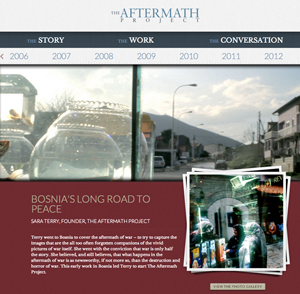 Terry stepped up to offer one more perspective on how funding photographers can help to generate debate and learning around tough issues. Previously a print reporter, Terry had “a crisis of confidence in words,” which led her to found The Aftermath Project, which runs an annual grant competition that supports photographers working on stories in places like Bosnia and Sierra Leone. Her goal was to inspire a new generation of “aftermath photographers,” dedicated to capturing not conflict, but its consequences.
Terry stepped up to offer one more perspective on how funding photographers can help to generate debate and learning around tough issues. Previously a print reporter, Terry had “a crisis of confidence in words,” which led her to found The Aftermath Project, which runs an annual grant competition that supports photographers working on stories in places like Bosnia and Sierra Leone. Her goal was to inspire a new generation of “aftermath photographers,” dedicated to capturing not conflict, but its consequences.
“Photography helps us define our humanity…and to understand what is inhuman. That’s the work that draws me,” she said. “In my world, impact is conversation, and to have a conversation, you need to fund work.” As a result, The Aftermath Project has funded a range of photographers and worked with Facing History and Ourselves to develop a curriculum about visual literacy and post-conflict rebuilding.
Yenkin wrapped up the session by sharing suggested goals for others seeking to support documentary photography projects — they should be ongoing, collaborative, innovative, and ethical, she said.
The Dialogue Continues…
Media Impact Funders’ Stehle reminded attendees that they could learn more about both media-focused philanthropy and approaches to impact evaluation on the Media Impact Funders web site. The Media Grants Knowledge Center, developed in collaboration with the Foundation Center, features maps of media grants in the U.S. while the AIM section of the site offers analysis, news and research on how best to assess how various types of media projects make a difference. Check back on our site for more details on upcoming events.
